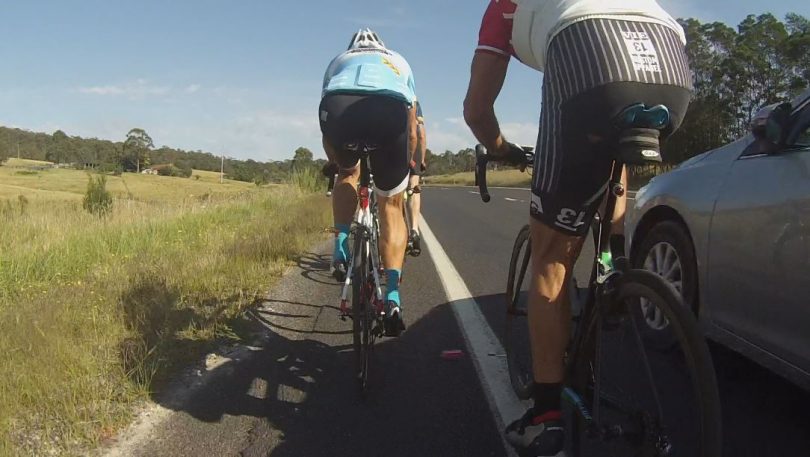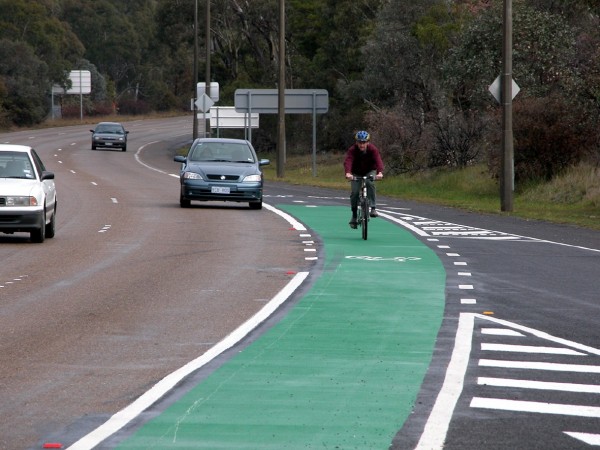
Hardly a 1.5-metre gap. Minimum passing distances for motorists overtaking cyclists are to become permanent in the ACT. Photo: Kate Smith.
Minimum passing distances for motorists overtaking cyclists are to become permanent in the ACT after a reduction in bicycle-related crashes during a two-year trial.
However, road rule changes to allow cyclists to remain on their bikes while riding across pedestrian crossings will also become permanent despite a marked increase in crashes with motor vehicles on crossings during the trial.
In tabling an evaluation report of the safer cycling reforms trial in the ACT Legislative Assembly today (October 25), ACT Road Safety Minister Shane Rattenbury highlighted the importance of improving cyclist safety in Canberra and took aim at “keyboard commentators” who are trying to further the feud between motorists and cyclists.
He said that some motorists are “disproportionately obsessed with cyclists”, with some people making “extremely disparaging and insensitive comments about cyclists, including about cyclists being injured and killed”.
“In the very least, I would ask these keyboard commentators to remember that every cyclist is a person, who is someone’s son or daughter, brother, sister, mother or father. It is not okay to endanger them, or to make light of their injuries or death,” Mr Rattenbury said.
The two-year safer cycling reforms trial began in November 2015 with the conditions of the trial remaining in place while an independent evaluation was undertaken by the University of Adelaide’s Centre for Automotive Safety Research.
The trial required motorists to provide a minimum overtaking distance when passing cyclists of 1 metre in speed zones of 60 kilometres per hour or less, and 1.5 metres in speed zones greater than that.
The road rules were also amended to allow motorists to cross, straddle or drive on centre-lines and painted islands when overtaking cyclists, provided the passing manoeuvre is safe to undertake, with a clear view of any approaching traffic.
The trial also allowed for riders to remain on their bicycles when crossing at pedestrian crossings as long as they met certain conditions, such as slowing and crossing at a speed no greater than 10 kilometres per hour (the ‘pedestrian crossing allowance’).
Below is an ACT Policing video about safely overtaking cyclists shared from Facebook.
Do you know how to safely overtake a cyclist?Be patient and leave at least 1 metre distance when passing at 60km/h or less or 1.5 meters for speeds over 60km/h. Remember if you’re unsure, leave more!To learn more about your responsibilities on the road visit: goo.gl/VTSUqN#ShareTheRoad #UnsureLeaveMore
Posted by ACT Policing on Thursday, August 23, 2018
Crash data shows fewer bicycle crashes but more on crossings
The evaluation of the trial looked at crash data for two years before and two years after it started. It found that:
- the total number of reported bicycle-related crashes reduced from 401 to 386
- the number of minimum passing distance related crashes also reduced slightly from 20 to 18
- the number of crashes between cyclists and motor vehicles at pedestrian crossings rose from 22 to 35
The latter finding seems to back up some community concerns about riding across crossings with the evaluation report stating that “during both the pre- and post-trial surveys, some participants expressed concerns that some cyclists may suddenly ride across pedestrian crossings from footpaths without giving enough time for motorists to react”.
In his tabling statement, Mr Rattenbury said the increased number of crashes on pedestrian crossings “may indicate that cyclists riding on these paths may not be slowing adequately to the required speed of 10 km/h when approaching pedestrian crossings, or motorists are not looking out for cyclists approaching”.
“Interestingly, there was a small decrease in the number of collisions between cyclists and motor vehicles on pedestrian crossings at locations where there were no shared paths and no crashes reported between pedestrians and cyclists while riding across pedestrian crossings during the trial period,” Mr Rattenbury said.
“I’d also like to point out that the evaluation notes four crossings where the most crashes occurred. Three of these crossings have had recent traffic calming upgrades, such as speed humps, which I hope and expect will mitigate the potential for collisions between cyclists and motor vehicles.”

The reforms aim to make cycling safer in the ACT. File photo.
Only 11 infringements issued in two years
The level of enforcement during the trial was low, with only 11 motorists issued with a traffic infringement notice or caution for not obeying the minimum passing distance rule, and only one cyclist issued with a traffic infringement notice for non-compliance with pedestrian crossing allowances.
Given the limited number of crashes and infringements during the trial, the evaluation said that it wasn’t able to make “statistically significant conclusions”.
Mr Rattenbury said that he is discussing better ways to enforce the new road rules with ACT Police Minister Mick Gentleman.
“Some of the interesting possibilities include police using a ‘lateral measuring device’ as a tool to enforce and educate road users on the laws,” Mr Rattenbury said.
“Police could also deploy an officer on a bicycle, who notes vehicles that pass closely and radios ahead to another officer.
“Another opportunity is for police to open a user-friendly portal through which cyclists (or other road users) could submit recorded footage of incidents.”
Increased community support for reforms
The evaluation did show that there was an improvement in community sentiment about the reforms – with awareness of the reforms doubling over the course of the trial (from 36 per cent to 70 per cent).
Support for both the minimum passing distance and pedestrian crossing allowance reforms also increased. By the end of the trial, 91 per cent of residents were at least ‘somewhat supportive’ of a minimum overtaking distance for motorists passing cyclists (47 per cent of which were ‘very supportive’).
Sixty-seven per cent of residents were at least ‘somewhat supportive’ of cyclists being allowed to slowly ride across pedestrian crossings, rather than having to stop and dismount to cross, which is also perceived as a significant increase in support compared to 2015.
The Government’s announcement that it will permanently retain minimum distance passing rules has been welcomed by Pedal Power ACT and the Amy Gillet Foundation.
Pedal Power ACT CEO Ian Ross said that making the rules permanent sends a signal to drivers that they need to share the road with other users.
“Anecdotally Pedal Power members are telling us they’ve seen the behaviour of motorist improve in the three years since the laws first came in, and this is backed up by the reports which shows a reduction in crashes,“ said Mr Ross.
Do you agree that the trialled road rule changes affecting cyclists should be permanent? Do you think the ‘feud’ between motorists and cyclists has gotten out-of-hand in the ACT? Let us know in the comments below.












